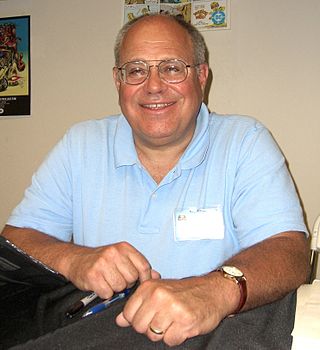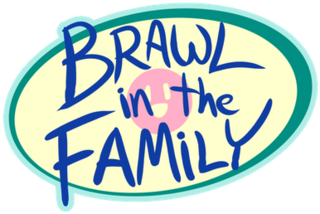A comic strip is a sequence of cartoons, arranged in interrelated panels to display brief humor or form a narrative, often serialized, with text in balloons and captions. Traditionally, throughout the 20th and into the 21st century, these have been published in newspapers and magazines, with daily horizontal strips printed in black-and-white in newspapers, while Sunday papers offered longer sequences in special color comics sections. With the advent of the internet, online comic strips began to appear as webcomics.
Webcomics are comics published on the internet, such as on a website or a mobile app. While many webcomics are published exclusively online, others are also published in magazines, newspapers, or comic books.

Sprite comics are webcomics that consist primarily of computer sprites from video games. Art assets are ripped from various classic games such as Mega Man and Sonic the Hedgehog, are edited and combined by amateur cartoonists, and are posted on the internet. Popularized by Bob and George in the early 2000s, the style is considered relatively easy for beginning cartoonists to get involved in, but sprite comics are generally looked down upon for being of low quality. The format has not seen mainstream attention since 8-bit Theater concluded in 2010.
8-Bit Theater is a sprite comic created by Brian Clevinger that ran from 2001 to 2010 and consisting of 1,225 pages. It is a sprite comic, meaning the art is mainly taken from pre-existing video game assets. The webcomic was at times one of the most popular webcomics, and the most popular sprite comic.

Kim Deitch is an American cartoonist who was an important figure in the underground comix movement of the 1960s, remaining active in the decades that followed with a variety of books and comics, sometimes using the pseudonym Fowlton Means.

Brian Clevinger is an American writer best known as the author of the webcomic 8-Bit Theater and the Eisner-nominated print comic Atomic Robo. He is also the author of the self-published novel Nuklear Age.

Real Life is an American webcomic drawn and authored by Maelyn Dean. It began on November 15, 1999, and is still updated, after breaks from December 10, 2015, to September 10, 2018, and again from July 16, 2019, to June 15, 2020, and most recently, from December 6, 2022 to present. The comic is loosely based around the lives of fictionalized versions of Dean and her friends, including verbatim conversations, as well as fictional aspects including time travel and mecha combat. Characters regularly break the fourth wall. Real Life focuses on humor related to video games and science fiction, and references internet memes.

VG Cats is a webcomic written and drawn by Canadian cartoonist Scott Ramsoomair. Published on its own website, it follows the adventures of a pair of anthropomorphic cats, who often played the roles of characters in popular video games that are parodied in the strip.

Proto Man, known in Japan as Blues, is a fictional character from Capcom's Mega Man video game series. Proto Man first appeared in the 1990 video game Mega Man 3 as a mini-boss Mega Man had to face periodically, and was known as Break Man. At the end of Mega Man 3, it is revealed that Break Man's actual name is Proto Man, and that he is Mega Man's older brother. Proto Man made further appearances in many more Mega Man games, sometimes as a playable character, often receiving critical praise.
The comic strip switcheroo was a massive practical joke in which several comic strip writers and artists (cartoonists), without the foreknowledge of their editors, traded strips for a day on April Fools' Day 1997. The Switcheroo was masterminded by comic strip creators Rick Kirkman and Jerry Scott, creators of the Baby Blues daily newspaper comic strip.
A Lesson Is Learned But The Damage Is Irreversible (ALILBTDII) is a webcomic drawn by David Hellman and written by Dale Beran. Ted Rall described the comic as "explor[ing] the limits of pessimism and fatal consequence in a universe that would be difficult to imagine on the printed page." David and Dale are the primary characters, although they do not appear in every episode, and there is a small cast of real-life supporting characters, including schoolfriend/mad scientist Paul, Dale's sister Sally, and David's mother, Debby Hellman.

Kristofer Straub is an American web cartoonist, performer, and content creator. His key web comic projects include Checkerboard Nightmare, Starslip, Chainsawsuit, Broodhollow, and F Chords. Other notable projects include the creepypasta "Candle Cove" as well as collaborations with Scott Kurtz ("Blamimations"), Paul Verhoeven, and Penny Arcade.
Multiplex is a comedy webcomic written and drawn by Gordon McAlpin which ran from 2005 to 2017. The comic focuses on the lives of the staff of the Multiplex 10 Cinemas and the movies that play there. Originally envisioned as an animated short, Multiplex is visually inspired by cut paper animation and vector graphics. Three print collections of the webcomic were released from 2010 to 1017. McAlpin's webcomic ended in April 2017, and the series is to be rebooted in the form of a stand-alone animated film, titled Multiplex 10.
Dueling Analogs is a webcomic by Steve Napierski. The website was launched on November 17, 2005, and new comics were posted every Monday and Thursday. Dueling Analogs is a gaming comic and as such most of the comics take place in the universe of the games discussed. There are few ongoing stories or plotlines as all of the comics are self-encapsulated ; however, there are repeated themes such as 'Rejected Mega Man Villains', 'Games that I am glad were never made' and 'What if...?'. Dueling Analogs is also a founding member of a webcomic group of gaming comics. The comic came to prominence in the webcomic community after the "So Dark the Contra of Man" strip.

Robert "Bob" Rozakis is an American comic book writer and editor known mainly for his work in the 1970s and 1980s at DC Comics, as the writer of 'Mazing Man and in his capacity as DC's "Answer Man".

Ctrl+Alt+Del (CAD) is a gaming-related webcomic and animated series written by Tim Buckley. The name of the comic refers to the Windows command Control-Alt-Delete. Premiering on October 23, 2002, the comic's focus has gradually shifted away from single strip gags towards longer story arcs and greater continuity through the use of video game references. Ctrl+Alt+Del currently is updated every Monday, Wednesday and Friday.

Brawl in the Family was a gag-a-day webcomic written and drawn by Matthew Taranto. The webcomic was inspired by the Super Smash Bros. series and features characters from various video game franchises, predominantly Nintendo series such as Kirby, Super Mario, Pokémon, F-Zero, and Metroid. The webcomic concluded on October 3, 2014, having produced a total of 600 comics.
The history of webcomics follows the advances of technology, art, and business of comics on the Internet. The first comics were shared through the Internet in the mid-1980s. Some early webcomics were derivatives from print comics, but when the World Wide Web became widely popular in the mid-1990s, more people started creating comics exclusively for this medium. By the year 2000, various webcomic creators were financially successful and webcomics became more artistically recognized.
Notable events of the late 1990s in webcomics.











